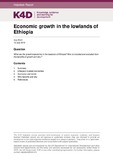| dc.description.abstract | The livestock sector dominates economic activity in Ethiopia’s lowlands that cover most of the country’s administrative regions. However, this review focuses specifically on Afar and Somali regions and on the lowland parts of Oromia region and the Southern Nations, Nationalities and Peoples’ Region (SNNPR). Lowland grazing systems are thought to contribute 35 percent of red meat and 56 percent of milk to Ethiopia’s livestock sector GDP (Shapiro, Gebru, Desta, Negassa, Nigussie, Aboset & Mechale, 2017, p. 32).While livestock sales are the most important contributor to household income across all four regions (Gebremedhin, Woldehanna, Flintan, Wieland & Poole, 2017, p. 26), there is growing concentration of wealth at the top of the income distribution. Average herd sizes have been falling for decades, and now the majority of households in lowland regions no longer have herds that meet the minimum threshold for viability.These trends are contributing to an acceleration of diversification and sedentarisation in lowlands, both within livestock systems and outside them. Activities once regarded as survival strategies by the poor, such as charcoal burning and firewood sales, are now permanent and lucrative businesses. The impacts of these changes in lowland economies are experienced differently by different social groups. Factors such as wealth, gender, age, location, and level of education influence how the benefits of economic growth are distributed. Several of the studies reviewed for this report conclude that a central element of any economic development strategy in lowlands should be education and skill development, particularly of women and girls. Apart from its intrinsic good, this is seen as a pathway to opportunity, either within or outside lowland regions. However, there is currently insufficient demand within the economies of these regions to provide jobs for the numbers who already need them, reinforcing the importance of measures that expand employment opportunities for the larger and better-educated workforce of the future. | en |

